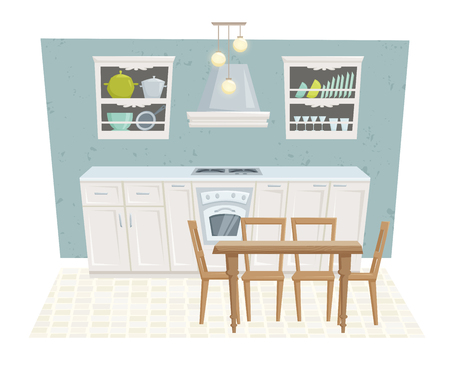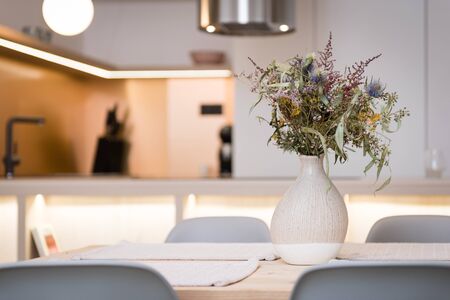Introduction to Open Kitchen Concepts
Open kitchens are quickly becoming a staple in American homes, reflecting a shift in the way we live, entertain, and connect with our spaces. This trend celebrates a layout that breaks down traditional walls—both literally and figuratively—inviting natural light, seamless flow, and social interaction into the heart of the home. Today’s homeowners are embracing open kitchens for their ability to blend cooking, dining, and living areas into one unified space, making everyday life more flexible and communal. The open kitchen isn’t just about showing off a chic stove or marble island; it’s about creating a welcoming environment where family and friends can gather, chat, and share moments as meals come together. As we explore the art of blending an open kitchen with different interior styles, it becomes clear why this versatile concept is much more than just a design choice—it’s a reflection of contemporary American values: inclusivity, functionality, and comfort.
2. Mixing Classic and Modern Design Elements
If you’re aiming to create an open kitchen that feels both timeless and fresh, blending classic and modern design elements is the way to go. American homes often thrive on a mash-up of old-school charm and cutting-edge flair, resulting in spaces that tell a story while feeling totally now. Whether you’re a fan of retro vibes, mid-century mod, or sleek contemporary lines, here’s how you can blend it all for a kitchen that’s truly one-of-a-kind.
Retro Vibes Meet Today’s Comforts
Start by picking out features from different eras that speak to you. Picture vintage checkerboard floors paired with high-gloss cabinets or a 1950s-inspired Smeg fridge sitting next to ultra-modern quartz countertops. The key is to balance nostalgia with function—think classic fixtures updated in modern finishes or bold colors reminiscent of the past paired with minimalist hardware.
Mix-and-Match Inspiration Table
| Style Element | Retro | Mid-Century Mod | Contemporary |
|---|---|---|---|
| Cabinetry | Plywood w/ metal pulls | Walnut slab doors | Matte lacquer handle-less |
| Countertops | Checkerboard laminate | Butcher block | Quartz/Concrete |
| Lighting | Diner pendants | Sputnik chandeliers | Recessed LED strips |
| Backsplash | Subway tile (colored) | Geometric mosaic tile | Large-format glass or stone |
| Appliances | Smeg pastel range | Bespoke panel fronts | Sleek stainless steel |
| Seating | Diner booth bench | Eames molded chairs | Acrylic stools/minimalist bar chairs |
Tips for Seamless Blending:
- Choose a unifying color palette: Stick with two to three main hues so your mix doesn’t feel chaotic.
- Edit your accents: Use statement pieces—a retro light fixture or mid-century bar stools—to anchor the space without overwhelming it.
- Add texture: Combine glossy surfaces with natural wood or patterned textiles for extra depth.
This approach isn’t just about aesthetics; it’s about expressing your personality and making your open kitchen the heart of your home. By thoughtfully mixing classic and modern styles, you’ll create a welcoming space that captures the spirit of American design—past, present, and future.

3. Choosing the Right Materials and Finishes
When youre blending an open kitchen with different interior styles, nailing down the right materials and finishes is key to keeping things cohesive yet dynamic. Think of your countertops, cabinetry, and hardware as the bridge between design eras—a classic marble slab can add a touch of timeless elegance, while butcher block brings in warmth that nods to both farmhouse charm and mid-century cool. Don’t be afraid to mix it up: pairing sleek quartz counters with vintage-inspired wooden cabinets can create a unique visual rhythm that feels intentional and lived-in. For cabinetry, consider shaker doors for a bit of retro Americana or flat-panel fronts for that streamlined modern look; just make sure the finish—whether painted, stained, or natural—complements other elements in your space. Hardware acts like the jewelry of your kitchen; brushed brass pulls lend a dash of art deco flair, while matte black knobs offer industrial edge without overpowering softer details. The secret? Stick with a consistent undertone or metal finish throughout—even if you’re mixing shapes or styles—to keep the overall vibe harmonious. Ultimately, selecting materials and finishes that echo elements from each style in your home lets your open kitchen feel effortlessly integrated, as if every detail has its own story but they all belong to the same novel.
4. Smart Layouts for Function and Flow
When it comes to open kitchens, layout is everything—especially in American homes where entertaining is a way of life. Blending an open kitchen with various interior styles means your space must not only look stunning, but also work seamlessly for daily living and gatherings. Here’s how to strike that coveted balance between flair and function:
Advice for Balancing Style & Practicality
First, think about the work triangle: the arrangement between your stove, sink, and refrigerator. This classic concept ensures efficient movement during meal prep. But don’t forget modern needs—open kitchens often double as social hubs, so consider traffic flow to prevent bottlenecks when guests arrive.
Key Elements of a Smart Open Kitchen Layout
| Element | Purpose | Tips for Blending Styles |
|---|---|---|
| Island or Peninsula | Extra workspace, casual seating, visual anchor | Mix countertop materials (marble, butcher block) to echo different eras or styles |
| Zoned Lighting | Task lighting for cooking, ambient for dining/entertaining | Combine retro pendants with contemporary recessed lights for a layered look |
| Open Shelving & Closed Storage | Display style pieces, hide clutter | Use reclaimed wood shelves with sleek cabinets for a mid-century-meets-modern effect |
| Flexible Seating Arrangements | Accommodate both daily meals and parties | Add vintage bar stools or eclectic chairs around the island for personality |
| Cohesive Color Palette | Ties together different design elements | Select hues that bridge adjoining rooms—think soft pastels with bold accents or classic neutrals with pops of color |
The Entertainer’s Edge: American-Style Hosting Tips
An open kitchen should invite conversation. Consider features like a beverage center, snack station, or even a record player nook to keep guests mingling. Use area rugs or distinctive floor tiles to subtly separate zones without interrupting sightlines—a nod to both practicality and style. Ultimately, smart layouts make it easy to blend old-school charm with new-age convenience, ensuring your kitchen is always ready for everything from family breakfasts to weekend dinner parties.
5. Personal Touches with Vintage and Local Finds
To truly blend an open kitchen with different interior styles, infusing your space with personal touches is key. Start by hunting for antique pieces at local flea markets or vintage shops—think a retro bar cart, a mid-century breadbox, or a set of classic ceramic canisters. These unique finds not only spark conversation but also echo stories from the past, adding soul to your modern setup.
Classic Colors: Setting the Mood
When it comes to color, choose timeless shades that have stood the test of time in American homes. Deep navy blues, muted forest greens, and rich terracotta tones pair beautifully with crisp whites or soft creams. These hues work well across different design eras and help create cohesion between your kitchen and adjoining spaces, whether you’re leaning farmhouse, industrial, or contemporary.
Regionally-Inspired Décor
Let your kitchen reflect its roots by incorporating regionally-inspired décor. In New England, opt for nautical accents like weathered wood trays or vintage lobster traps repurposed as storage. If you’re in the Southwest, introduce hand-painted Talavera tiles or woven baskets from local artisans. For a Midwest vibe, reclaimed barnwood shelves or vintage enamelware nod to rural traditions while still feeling fresh.
Mixing Old with New
The beauty of this approach is in the mix: combine a classic shaker cabinet with a retro diner stool or hang a collection of local landscape paintings alongside industrial pendant lights. Don’t be afraid to let your finds tell your story—after all, blending an open kitchen with different interior styles is about celebrating heritage while embracing what’s current and uniquely yours.
6. Lighting and Atmosphere
When it comes to blending an open kitchen with different interior styles, lighting is your best friend for setting the mood and tying everything together. Statement lighting—think bold pendant lamps over the island or an industrial chandelier above a rustic farmhouse table—can instantly define zones in an open space and give your kitchen its own personality. Don’t be afraid to go big: a mid-century sputnik light fixture or vintage-inspired glass globes can bridge classic and contemporary vibes, making your kitchen feel both curated and lived-in.
Layered Lighting for Depth
Layering your lighting is key in American homes, where kitchens often double as social hubs. Combine ambient lights (like recessed ceiling fixtures) with task lighting under cabinets and accent lights that highlight architectural features or eclectic décor. This approach lets you shift from bright, energetic mornings to cozy evening gatherings at the flick of a switch, adapting to every moment of the day.
Textures Make It Homey
Lighting isn’t just about bulbs—it’s also about what the light touches. Layer textures throughout your kitchen: matte subway tiles, polished marble counters, rough-hewn wood beams, or even a splash of retro terrazzo flooring. Soft textiles like linen curtains or leather bar stools catch the light differently, adding warmth and depth while connecting disparate design eras.
Mix & Match for Authentic Vibes
Embrace the American spirit of mixing old and new by pairing statement lighting with unexpected textures: hang a sleek brass fixture over a reclaimed wood table, or place modern LED strips alongside vintage tile backsplashes. The interplay between lighting and materials makes your open kitchen feel dynamic and personal—a true reflection of your unique style blend.
Ultimately, choosing impactful lighting and thoughtfully layered textures allows your blended kitchen to shine as both a functional workspace and a welcoming gathering spot, perfectly suited for everyday living and special occasions alike.


